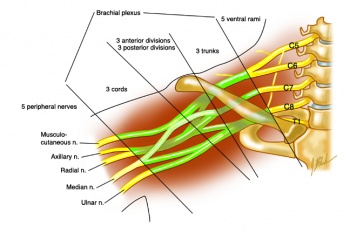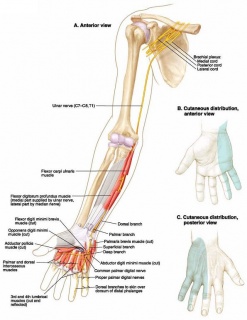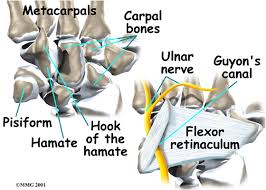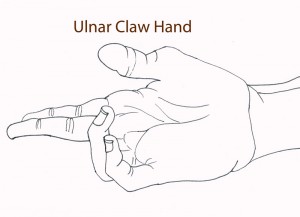Ulnar Nerve Entrapment
Original Editor Trevor Bradshaw ; and Robert Bardinas; as part of the Temple University Evidence-Based Practice Project
Top Contributors - Vanessa Rhule, Trevor Bradshaw, Nikhil Benhur Abburi, Admin, Robert Bardinas, Kim Jackson, Aimee Tow, Rachael Lowe, WikiSysop, Noah Lahjouji, Scott A Burns, Simisola Ajeyalemi, Uchechukwu Chukwuemeka, Lauren Kwant, Amanda Ager, Anas Mohamed, Laura Ritchie and Fasuba Ayobami
Clinically Relevant Anatomy
[edit | edit source]
Clinically Relevant Anatomy
Ulnar nerve entrapment typically occurs at two main sites: the cubital tunnel and guyon’s canal. Guyon’s canal syndrome, also known as ulnar tunnel syndrome, is much less common than cubital tunnel syndrome.
- The ulnar nerve can also be disrupted at other sites if a fracture of the humerus, radius, or ulna is sustained. Rarely, vascular pathology can lead to compression at atypical sites as well.
- Function of the nerve can be compromised distal to the site of the lesion.
Course of the Ulnar nerve:
Originates from the C8-T1 nerve roots.
- There is a possible minor involvement of the C7 nerve root as well.
- The ulnar nerve branches off the medial cord of the brachial plexus.
- The ulnar nerve runs just medial to the axillary artery, and continues down the humerus.
- About halfway down the humerus, the ulnar nerve pierces the medial intermuscular septum, and passes back over the medial head of the triceps.
- The nerve continues around the posterior aspect of the medial epicondyle and goes through the ulnar groove.
- It then courses underneath the tendonous arch also known as the cubital tunnel (humeral-ulnar aponeurosis), which is formed by the two heads of the flexor carpi ulnaris, and enters into the anterior compartment of the forearm.
In the forearm the nerve branches off and innervates:
- Flexor carpi ulnaris: Flexion and Adduction of wrist
- Ulnar portion of the Flexor digitorum profundus: Flexes distal phalanges at distal interphalangeal joints of digits 2-5 and assists with flexion of hand
- Dorsal cutaneous sensory branch - Supplies sensation to the dorsal aspect of the fifth finger and the dorsal medial portion of the 4th finger
- Palmar cutaneous branch of the ulnar nerve - Supplies sensation to the palmar aspect of the fifth finger and the palmar medial portion of the 4th finger.
- The ulnar nerve continues down the forearm medially and enters into the hand though the Guyon’s canal.
Guyon’s canal
- Proximal wall - Pisiform bone
- Distal wall - Hook of the hamate
- Floor- Combination of the thick transverse carpal ligament, the hamate and triquetrum bones
- Roof- Narrowed by a ligament running from pisiform to hamate.
In the hand the ulnar nerve branches off into:
- Superficial branch of ulnar nerve - Supplies the Palmaris brevis, steadies and corrugates skin of palm to help with grip
- Deep branch of ulnar nerve - Supplies the interossei, third and fourth lumbricals, the adductor pollicis, and part of the flexor pollicis brevis.
Mechanism of Injury / Pathological Process[edit | edit source]
- Prolonged compression of the elbow
- Fracture
- Overuse of elbow flexion
- Bone pathologies or abnormalities at the elbow
Guyon’s Canal Syndrome
- Biking hand hold
- Handlebar palsy
- Fractures
- Bone pathologies or abnormalities at the wrist
Other sites of ulnar nerve compression
- Trauma resulting in fracture/dislocation
Clinical Presentation[edit | edit source]
Clinical Presentation[1][2][3][4][5][6]
Symptoms of ulnar nerve entrapment depend on the diagnosis, or location of the lesion.
Is considered a repetitive stress injury where the ulnar nerve becomes entrapped with the cubital tunnel which is formed by the medial epicondyle, flexor carpi ulnaris and ligaments of the olecranon process of the ulna. Primarily affects anyone whose motions incorporate repetitive or prolonged elbow flexion such as leaning on the elbows.
Cubital Tunnel Syndrome can present in different grades of severity:
- Grade I: Mild symptoms
- Intermittent paresthesia
- Minor hypoesthesia of the dorsal and palmar surfaces of the fifth and medial aspect of fourth digits
- No motor changes
- Grade II: Moderate and persistent symptoms
- Paresthesia
- Hypoesthesia of the dorsal and palmar surfaces of the fifth and medial aspect of fourth digits
- Mild weakness of ulnar innervated muscles
- Early signs of muscular atrophy
- Grade III: Severe symptoms
- Paresthesia
- Obvious loss of sensation of the dorsal and palmar surfaces of the fifth and medial aspect of fourth digits.
- Significant functional and motor impairment
- uscle atrophy of the hand intrinsics
- Possible digital clawing of fourth and fifth digits (Sign of Benediction)
Guyon’s canal syndrome
The ulnar nerve becomes entrapped between the hook of the hamate and the transverse carpal ligament which makes up the Guyon’s canal. Guyon’s canal syndrome is considered an overuse injury which is commonly caused by direct pressure on a handlebar (ie. Bicyle handlebar, weight lifting, construction equipment) and therefore, is sometimes referred to as “handle barpalsy”. It can also result from excessive gripping, twisting, or repeated wrist and hand motions. Also, entrapment may develop if the hand is flexed and ulnar deviated for prolonged periods of time.
Symptoms caused by this syndrome consist of:
- Muscular atrophy - Primarily the hypothenar muscles and interossei with muscle sparing of the thenar group:
- weakened finger abduction and adduction (interossei)
- weakened thumb adductor (adductor pollicis)
- Sensory loss and pain -
- May involve the palmar surface of the fifth digit and medial aspect of the fourth digit.
- Dorsum of medial aspect of the fourth finger and the dorsum of the fifth finger don’t have sensory loss.
- Ulnar Claw may present (sign of Benediction)
Ulnar nerve compression due to trauma 11
The incidence of trauma leading to ulnar nerve compression is unknown; however ulnar neuropathy has been documented after distal humeral fractures and in up to 10% of elbow dislocations, and may also develop from any complex elbow or wrist trauma.
Diagnostic Procedures[7][8]
[edit | edit source]
Cubital Tunnel Syndrome Physical Exam:
- Rule out other diagnoses which could refer to the elbow (listed below)
- ROM of the elbow (flexion may be limited secondary to pain)
- MMT of the ulnar nerve muscles innervated distal to the cubital tunnel
- Sensory exam of the cutaneous ulnar nerve distribution (palmar 5th digit and ulnar side of the 4th digit may be diminished)
- Upper Limb Tension Test for the ulnar nerve
Special Tests:
- Tinnel’s sign at the cubital tunnel (Sensitivity: 0.7, Specificity: 0.98)
- Elbow flexion test (Sensitivity: 0.75, Specificity: 0.99)
- Pressure provocative test (Sensitivity: 0.89, Specificity: 0.98)
- Card test
Guyon’s Cannal Syndrome
Physical Exam:
- Rule out other diagnoses which could refer to the elbow (listed below)
- ROM of the wrist and digits
- MMT of ulnar nerve muscles innervated distal to Guyon’s Canal
- Sensory exam of the ulnar nerve cutaneous distributiondistal to Guyon’s Canal
- Muscle wasting of intrinsic hand muscles
Special Tests:
- Card test
- Froment’s Sign
- Tinnel’s sign at Guyon’s canal
- Ulnar neurodynamic test (ULTT3) may increase the patient’s symptoms
Other ulner nerve sites
Physical Exam:
- Identify the location of the lesion/disruption with diagnostic imaging
- Medical emergency
- MMT of involved muscles innervated distal to the lesion
- Sensory exam of involved sensory innervations distal tot eh lesion
Diagnostic Tests for Ulnar Nerve Entrapment2:
- Imaging for OA, bone spurs, or bone cysts
- Nerve Conduction Studies (site of decreased nerve conduction velocity may indicate the site of compression)
- EMG to determine if muscle wasting has occurred
- If fracture/dislocation is suspected, further imaging would be ordered to obtain a diagnosis
Outcome Measures[9][edit | edit source]
- Disabilities of the Arm, Shoulder, and Hand - A 30 item questionnaire, targeted towards measuring the physical function and symptoms of patient
- Patient Specific Functional Scale (PSFS) - A questionnaire that is utilized to quantify activity limitations and measure functional outcomes of patients
- DASH Outcome Measure - A questionnaire that measures a patient’s functional ability and severity of their symptoms
- Upper Extremity Functional Index (UEFI) - A questionnaire of 20 items regarding severity of difficulty performing activities throughout the day
Management / Interventions
[edit | edit source]
Cubital Tunnel Syndrome
In a study conducted by Svernlov and colleagues, three treatments were compared for individuals with cubital tunnel syndrome (see below).[10] All three groups had positive outcomes, with the control group improving just as much as the intervention groups.[10]
- Splint group protocol[10] - An elbow brace was worn every night for a period of three months and the brace prevented elbow flexion beyond 45 degrees.
- Nerve gliding protocol[10] - Patients were instructed to complete nerve gliding exercises two times per day in six different positions and hold them for 30 seconds for three repetitions with a 1 minute break in between each repetition. Patients were instructed to complete these exercises until the next visit, which occurred 1-2 weeks later. The frequency of the exercises were increased to three times per day, holding the exercise for one minute each day for a period of three months if there were no symptoms at the next visit.
- Control group protocol[10] - The control group only received education
According to a case report by Coppieters and colleagues, joint mobilizations of the elbow, thoracic spine and rib thrust manipulations, and ulnar nerve sliding/tension techniques for six sessions were associated with improvements of decreased elbow pain and considerable improvement scores on a neck questionnaire up to a ten month follow-up.[11] The patient reported a history of symptoms for two months prior to starting physical therapy.[11] The protocol used in this study can be seen by accessing the link in the case study section below.
Guyon’s Canal Syndrome and other ulnar nerve sites:
- impairment based approach can be used to address deficits in strength, ROM, and the attainment of functional goals
- A patient’s impairments that lead to the production of pain should be coupled with a sign, such as ROM or strength.
- The source of the pain should be treated in conjunction with the impairments.
- Following treatment, reassess the functional task that produced pain to determine effective treatment outcome
- Administer a home exercise program that aims to treat the same impairments
Differential Diagnosis[2]
[edit | edit source]
The cervical spine and shoulder regions should be examined to rule out diagnoses that can refer to the elbow.
There are numerous differential diagnoses for ulnar nerve entrapment such as:
- Elbow fracture/dislocation
- Cervical Radiculopathy
- Thoracic Outlet Syndrome
- Peripheral Vascular Disease
- Ulnar collateral ligament injury
- Rheumatoid Arthritis
- Medial Epicondylalgia
- Guillain-Barre syndrome
- Alcohol (Ethanol) Related Neuropathy
- Amyotrophic lateral sclerosis
- Pancoast Tumor
- Primary Bone Tumors
- Peripheral polyneuropathy
Key Evidence[12][10]
[edit | edit source]
- Special tests that are utilized in the diagnosis of ulnar nerve entrapment have extremely high sensitivity of .98 and above and therefore are extremely useful in ruling in diagnosis.
- Conservative treatment is effective about 50% of the time, while surgical intervention is effective 60-95% of the time
- Conservative management has been proven effective when incorporating splinting and manual therapy including neural glides and joint mobilizations
- Patient’s seeking conservative treatment earlier rather than waiting have a thirty percent greater chance of avoiding surgery
Resources
[edit | edit source]
Recent Related Research (from Pubmed)[edit | edit source]
Failed to load RSS feed from http://eutils.ncbi.nlm.nih.gov/entrez/eutils/erss.cgi?rss_guid=1671MaA5CeAN2ph0udxwrr8SZWsom1s2bdIOHUKw53VS4: Error parsing XML for RSS
References[edit | edit source]
- ↑ Neuropathy of Ulnar Nerve (Entrapment). MD Guidelines. http://www.mdguidelines.com/neuropathy-of-ulnar-nerve-entrapment/differential-diagnosis. Accessed March 15, 2011.
- ↑ 2.0 2.1 Ulnar Neuropathy. Emedicine from WebMD. http://emedicine.medscape.com/article/1141515-overview. Updated June 10, 2010. Accessed March 15, 2011.
- ↑ Palmer BA, Hughes TB. Cubital Tunnel Syndrome. J Hand Surg. 2010: 35 (1): 153-163.
- ↑ Nerve Entrapment Syndromes. Emedicine from WebMD. www.emedicine.medscape.com/article/249784-overview Updated July 31, 2009. Accessed March 15, 2011.
- ↑ Ulnar Nerve Entrapment. American Academy of Orthopaedic Surgeons. http://orthoinfo.aaos.org/topic.cfm?topic=a00069. Updated October 2007. Accessed March 15, 2011.
- ↑ Shin R, Ring D. The Ulnar Nerve in Elbow Trauma. J. Bone Jt. Surg. (Am.). 2007: 89: 1108-1116.
- ↑ Ulnar Nerve Entrapment. Wikipedia. 2011. Available at: http://en.wikipedia.org/wiki/Ulnar_nerve_entrapment. Accessed March 17, 2011.
- ↑ Ulnar Nerve Entrapment. American Academy of Orthopaedic Surgeons. 2007. Available at: http://orthoinfo.aaos.org/topic.cfm?topic=a00069. Accessed March 17, 2011.
- ↑ ProQolid. http://www.proqolid.org/proqolid_1/generic. Updated 2011. Accessed March 15, 2011.
- ↑ 10.0 10.1 10.2 10.3 10.4 10.5 Svernlov B, Larsson M, Rehn K, Adolfsson L. Conservative treatment of the cubital tunnel syndrome. J Hand Surg Eur Vol. 2009;34(2):201-207.
- ↑ 11.0 11.1 Coppieters MW, Bartholomeeusen KE, Stappaerts KH. Incorporating nerve0gliding techniques in the conservative management of cubital tunnel. J Manipulative Physiol Ther. 2004;27(9):560-568
- ↑ Spinner RJ. Outcomes for Peripheral Nerve Entrapment. Clin Neurosurg. 2006; 53: 285-294.










